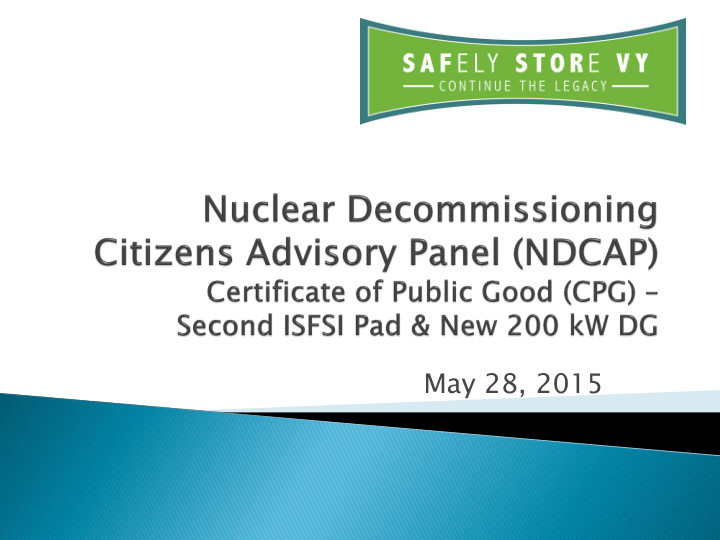



May 28, 2015
• Thirteen (13) Holtec 100 Dry Fuel Storage Casks are safely loaded and stored on the first of two (2) Independent Spent Fuel Storage Installation (ISFSI) pads. • An additional forty-five (45) Dry Fuel Storage Casks for a total of fifty- eight (58) will be loaded and stored on the two pads. • Capacity of the existing pad is thirty-six (36) Dry Fuel Storage Casks. • Application for a second ISFSI pad was submitted on June 30, 2014 to the Vermont Public Service Board (PSB) seeking a Certificate of Public Good (CPG). • The required capacity of the new pad is twenty-two (22) casks. • Current plan is to transfer all spent fuel to Dry Cask Storage by 2020. 2
Prop opos osed loca ocation ion of secon econd pad Exis isti ting ng ISFSI SFSI pad 3
• The Spent Fuel Pool currently stores 2,996 spent fuel assemblies at VYNPS to be moved to Dry Cask Storage. • The thirteen (13) Dry Cask Storage Casks contain 884 spent fuel assemblies. • A total of 3,880* spent fuel assemblies are stored at VYNPS. * This includes one (1) fuel debris canister 4
CPG Issued by PSB – Requested by Early May 2016 Commence Field Construction – June 15, 2016 Concrete Pour – October 2, 2017 2 nd ISFSI Pad In Service – November 15, 2017 Complete Transfer of Spent Fuel into Casks – Late 2020 5
• 5 by 5 Cask Array results in a 76’ by 93’ pad design. • Located approximately 30’ west of the existing pad. • Selected location provides optimum Security and pad access using existing infrastructure. • Requires the removal of the existing North Warehouse and 175kW diesel generator as well as underground utility relocation. • Extensive soil analyses concluded no potential seismic issues with the new pad location. • Same Design Basis Earthquake parameters and Design Basis Flood elevations as existing approved pad were used. • Design meets all NRC licensing requirements. 6
Prop opos osed loca ocation ion of 2008 File Photo second econd pad 7
Underground Storage (Holtec 100U) ◦ Cannot be constructed in Protected Area (PA) ◦ Outside of PA - Extensive Security Implications Above Ground Storage ◦ Evaluated Multiple Configurations and Locations Best Option - 5 by 5 Cask Array on Pad Adjacent to the Existing Pad 8
Existing 175 kW Diesel Generator to be replaced with 200 kW DG Barrier wall included in design to address NRC security requirements (10 CFR 73.55) Diesel Generator relocated/oriented to address NRC security requirements 9
5 by 5 cask pad design in Protected Area (PA) – Optimum for all design, and compliance issues. Detailed pad design is complete. Extensive soil analyses concluded no potential seismic issues with the new pad location. Supplementary testimony filed with the Public Service Board on May 11, 2015. Certificate of Public Good (CPG) needed by early May 2016 to support current construction and cask loading schedule. Construction of new pad needs to be complete by November 2017 to support all fuel in Dry Cask Storage by 2020. Cost of extending project beyond 2020 is estimated at $1.7M/month. 10
Recommend
More recommend